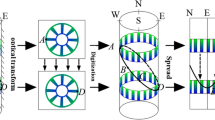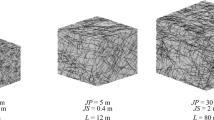Abstract
A rock mass classification system is intended to classify and characterize the rock masses, provide a basis for estimating deformation and strength properties, supply quantitative data for mine support estimation, and present a platform for communication between exploration, design and construction groups. In most widely used rock mass classification systems, such as RMR and Q systems, up to six parameters are employed to classify the rock mass. Visualization of rock mass classification systems in multi-dimensional spaces is explored to assist engineers in identifying major controlling parameters in these rock mass classification systems. Different visualization methods are used to visualize the most widely used rock mass classification systems. The study reveals that all major rock mass classification systems tackle essentially two dominant factors in their scheme, i.e., block size and joint surface condition. Other sub-parameters, such as joint set number, joint space, joint surface roughness, alteration, etc., control these two dominant factors. A series two-dimensional, three-dimensional, and multi-dimensional visualizations are created for RMR, Q, Rock Mass index RMi and Geological Strength Index (GSI) systems using different techniques. In this manner, valuable insight into these rock mass classification systems is gained.
Similar content being viewed by others
References
N. R. Barton R. Lien J. Lunde (1974) ArticleTitleEngineering classification of rock masses for the design of tunnel support Rock Mech. 6 IssueID4 189–239 Occurrence Handle10.1007/BF01239496
Z. T. Bieniawski (1973) ArticleTitleEngineering classification of jointed rock masses Trans. S. Afr. Inst. Civ. Eng. 15 335–344
Bieniawski Z. T. (1976) Rock mass classification in rock engineering, in: Proceedings of the Symposium on Exploration for Rock Engineering, Cape Town, Balkema, Vol. 1, pp. 97–106
Z. T. Bieniawski (1989) Engineering rock mass classifications Wiley New York
M. Cai P.K. Kaiser H. Uno Y. Tasaka M. Minami (2004) ArticleTitleEstimation of rock mass strength and deformation modulus of jointed hard rock masses using the GSI system Int. J. Rock Mech. Min. Sci. 41 IssueID1 3–19 Occurrence Handle10.1016/S1365-1609(03)00025-X
Feiner, S. and Beshers, C. (1990) Worlds within worlds: metaphors for exploring n-dimensional virtual worlds, in: Proceedings of the 3rd Annual ACM Symposium on User Interface Software and Technology (UIST’90), Snowbird, UT, USA, pp. 76–83
Y. Hashash D. Wotring J. Yao J. Lee Q. Fu (2002) ArticleTitleVisual framework for development and use of constitutive models Int. J. Numer. Anal. Meth. Geomech. 26 1493–1513 Occurrence Handle10.1002/nag.255
E. Hoek E. T. Brown (1980) ArticleTitleEmpirical strength criterion for rock masses J. Geotech. Eng. Div, ASCE 106 IssueIDGT9 1013–1035
Hoek, E. and Brown, E. T. (1988) The Hoek–Brown failure criterion – a 1988 update, in Rock engineering for underground excavations, in: Proceedings of the 15th Canadian Rock Mechanical Symposium, Toronto, Canada, University of Toronto, Toronto, pp. 31–38
E. Hoek E. T. Brown (1997) ArticleTitlePractical estimates of rock mass strength Int. J. Rock Mech. Min. Sci. 34 IssueID8 1165–1186 Occurrence Handle10.1016/S0148-9062(97)00305-7
Hoek, E. and Brown, E. T. (1988) The Hoek–Brown failure criterion – a 1988 update, in Rock engineering for underground excavations, in: Proceedings of the 15th Canadian Rock Mechanical Symposium, Toronto, Canada, University of Toronto, Toronto, pp. 31–38
Hoek, E., Kaiser, P. K. and Bawden, W. F. (1995) Support of Underground Excavations in Hard Rock, A.A. Balkema
B. Jeremie G. Scheuermann J. Frey Z. Yang B. Hamann K. I. Joy H. Hagen (2002) ArticleTitleTensor visualizations in computational geomechanics Int. J. Numer. Anal. Meth. Geomech. 26 925–944 Occurrence Handle10.1002/nag.223
A. Palmstrøm (1996a) ArticleTitleCharacterizing rock masses by the RMi for use in practical rock engineering, Part1: The development of the rock mass index (RMi) Tunnelling and Underground Space Technol 11 IssueID2 175–188 Occurrence Handle10.1016/0886-7798(96)00015-6
A. Palmstrøm (1996b) ArticleTitleCharacterizing rock masses by the RMi for use in practical rock engineering, Part2: Some practical applications of the rock mass index (RMi) Tunnelling and Underground Space Technol 11 IssueID3 287–303 Occurrence Handle10.1016/0886-7798(96)00028-4
Schroeder, R. (1996) Possible Worlds: The Social Dynamic of Virtual Reality Technology, Westview Press. (HarperCollins Publishers, Inc.)
Z. Sen B. H. Sadagah (2003) ArticleTitleModified rock mass classification system by continuous rating Eng. Geol. 67 IssueID3–4 269–280 Occurrence Handle10.1016/S0013-7952(02)00185-0
Author information
Authors and Affiliations
Corresponding author
Rights and permissions
About this article
Cite this article
Cai, M., Kaiser, P. Visualization of rock mass classification systems. Geotech Geol Eng 24, 1089–1102 (2006). https://doi.org/10.1007/s10706-005-7464-x
Received:
Accepted:
Issue Date:
DOI: https://doi.org/10.1007/s10706-005-7464-x




